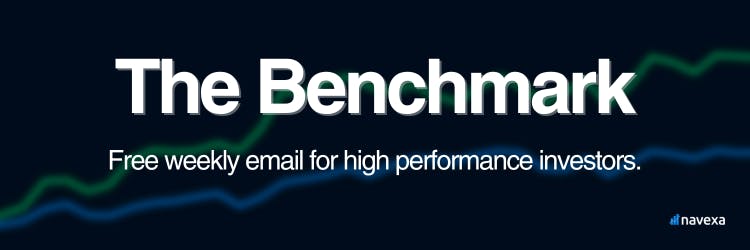May 6, 2024
Ray Dalio, debt cycles,
and the economic machine
Dear Reader,
What if you never had to worry about unforeseen financial events again?
What if you had a calendar that showed you what economies and markets were doing years in advance?
How valuable would that knowledge be?
This is what this week’s The Benchmark is about.
About 10 years ago, I stumbled upon Ray Dalio’s How The Economic Machine Works video.
It did for me in 30 minutes what no economics teacher or other ostensibly financially savvy person I’d met had managed:
Explain, in simple terms, what the economy is, how it behaves, and why.
Dalio’s thesis in brief:
Economies go through cycles of expansion and contraction.
The accumulation and deleveraging of debt drives this cycle.
This cycle consists of three main stages:
- Credit expansion
- Debt bubble
- Deleveraging
I’ll explain more after I explain what gives Ray Dalio the authority to explain such a seemingly complex thing as the economy in such simple terms.
Benchmark beater: Ray Dalio
From mowing lawns to raking in billions
Ray Dalio first started making money as a kid mowing lawns in New York.
A 2022 estimate valued his personal wealth at US$15.7 billion.
What happened in between?
Ray got good at understanding money and markets.
In 1974, unhappy with his employer (a trading firm), he got drunk at the Christmas party and punched his boss in the face.
After the firm let him go, some of its top clients chose to continue letting Ray manage their money.
The following year, he started Bridgewater Associates from his two-bedroom apartment.
The firm launched multiple funds in the course of becoming the largest hedge fund firm on the planet.
Some of the biggest entities in the world parked their money with Bridgewater.
This chart gives you an idea why:
Source: Wikipedia
We all like to marvel at lines that go up and to the right.
But what’s most interesting about this one — the Bridgewater Pure Alpha 1 fund’s performance between 1991 and 2015 — is how it ends up pretty much where the S&P500 does…
Without the massive falls in 2000 and 2008.
While stocks were tumbling amid the two bloodbaths…
Ray Dalio’s investors were making money.
That’s what qualifies this man to lecture the rest of us on what the economy is, how it behaves, and why.
Long-term productivity growth, with the short and long-term debt cycles overlaid.
As you’ll see in the video, there’s three key factors you need to understand:
Productivity Growth: Over time, we become more productive and raise our living standards.
Short-Term Debt Cycle: At the consumer level, our borrowing and deleveraging generally moves in ~6-year cycles.
Long-Term Debt Cycle: At the broader economic level, society’s borrowing and deleveraging generally happens in ~75-year cycles.
According to Ray, both the 1929 ‘Great Depression’ and the 2008 ‘Great Recession’ both marked the beginning of ‘deleveraging’ phases on the long-term debt cycle.
Understanding this fundamental economic truth was what allowed Bridgewater’s Pure Alpha 1 to effectively dodge the 2008 crash.
If the market is really this easy
to predict, where are we now?
Ray Dalio is not only one of the wealthiest people on the planet, financially speaking.
He’s also — I would argue — one of the wealthiest in terms of his knowledge and understanding of the financial world.
(And, as we like to remind you in The Benchmark, knowledge pays the best interest.)
Ray is about as on the money as one can get about the fundamental nature of the economic world we live in.
Here are some comments he made in 2023:
‘In my opinion the tightening that began in March 2022 ended the last paradigm in which central banks gave away money and credit essentially for free, which was great for the borrower-debtors.
‘We are now in a new paradigm in which central banks will strive to achieve balance, in which real interest rates will be high enough and money and credit will be tight enough to satisfy lender-creditors without interest rates being too high and money and credit being too tight for borrower-debtors.’
Dalio: 2024 a ‘pivotal year’
Ray’s January Principled Perspectives newsletter is a deep dive (an actual deep dive, not just another blog or email claiming to be) into how he sees these economic cycles playing out in the world.
It’s well worth a read, if you have the time and intellectual energy to absorb some very big ideas.
Here’s why:
‘2024 will almost certainly be a pivotal year in a number of ways— for example, we will find out whether the existing democratic order in the US will or won’t hold up well, and whether or not the world’s international conflicts will be contained.
‘Of course, like all years, 2024 and the events in it will be just small parts of the long string of years and events that make the Big Cycle arc of history, which is what is most important to pay attention to.’
If you’ve still not checked it out, watch How The Economic Machine Works now.
That’s it for this week’s The Benchmark email.
Forward this to anyone you know who needs to read it.
And, if one of our awesome subscribers has forwarded it to you…
Subscribe here for weekly emails with ideas, stories and content about long-term, high-performance investing!
Invest in knowledge,
Thom
Editor, The Benchmark
Unsubscribe · Preferences
All information contained in The Benchmark and on navexa.io is for education and informational purposes only. It is not intended as a substitute for professional financial or tax advice. The Benchmark and any contributors to The Benchmark are not financial professionals, and are not aware of your personal financial circumstances.
